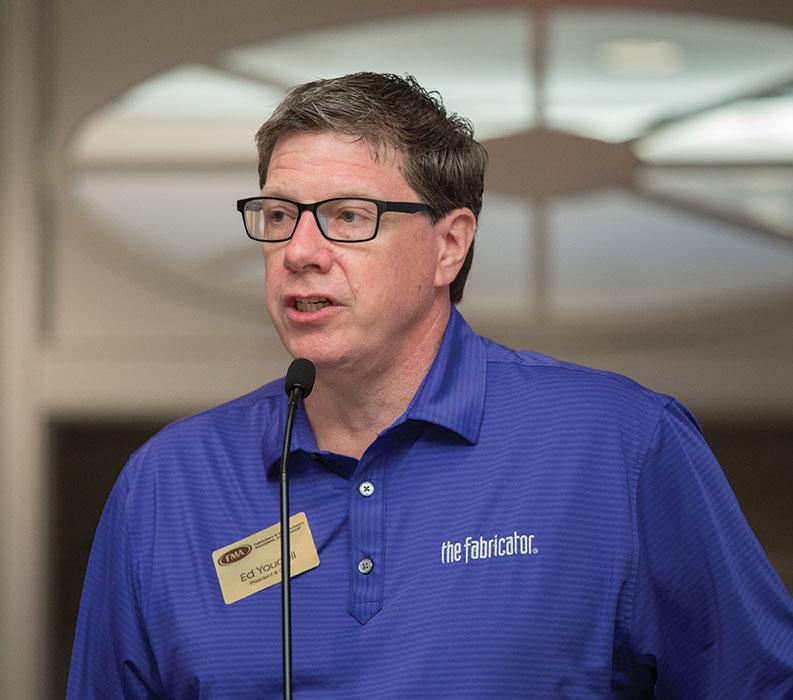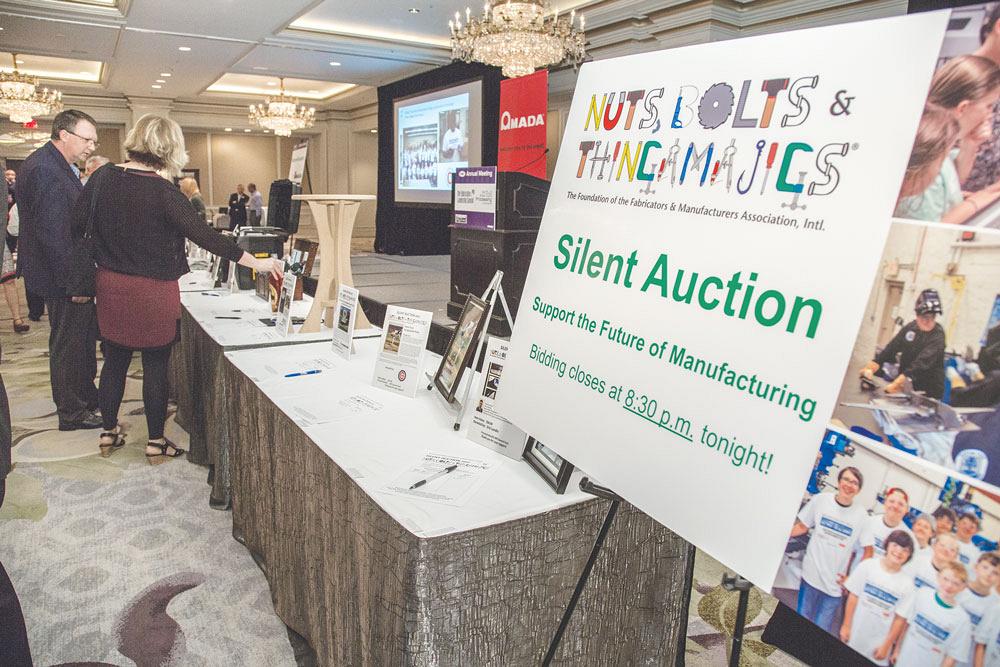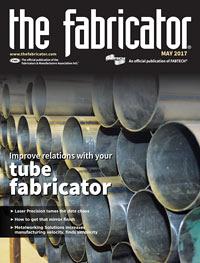Senior Editor
- FMA
- The Fabricator
- FABTECH
- Canadian Metalworking
Categories
- Additive Manufacturing
- Aluminum Welding
- Arc Welding
- Assembly and Joining
- Automation and Robotics
- Bending and Forming
- Consumables
- Cutting and Weld Prep
- Electric Vehicles
- En Español
- Finishing
- Hydroforming
- Laser Cutting
- Laser Welding
- Machining
- Manufacturing Software
- Materials Handling
- Metals/Materials
- Oxyfuel Cutting
- Plasma Cutting
- Power Tools
- Punching and Other Holemaking
- Roll Forming
- Safety
- Sawing
- Shearing
- Shop Management
- Testing and Measuring
- Tube and Pipe Fabrication
- Tube and Pipe Production
- Waterjet Cutting
Industry Directory
Webcasts
Podcasts
FAB 40
Advertise
Subscribe
Account Login
Search
Metal fabrication meets The Big Easy
The 2017 FMA Annual Meeting breaks attendance records
- By Tim Heston
- April 28, 2017
- Article
- Shop Management
Rarely is the best New Orleans music found in a concert hall where the audience sits separated from the performers by a proscenium, listening politely and then applauding at the end of each selection. It happens, but it isn’t New Orleans at its most identifiable. New Orleans music lovers … are much more likely to be found in places where they can dance to the music they love, holler encouragement, sing along, and, if at all possible, eat and drink at the same time.
So wrote Tom Piazza in his book, Why New Orleans Matters, published not long after Hurricane Katrina hit the city. Attendees at the Fabricators & Manufacturers Association’s Annual Meeting, which includes The FABRICATOR’s Leadership Summit and the 21st Annual Toll Processing Conference, got a taste of this Big Easy experience. The event drew more than 300 people, a record.
After a day of panel discussions, presentations, serious talk, and not-so-serious talk, attendees did something that doesn’t come to mind when you think about metal fabrication. They walked in a second line parade led by quintessential New Orleans brass and drums. Per tradition, the first line refers to the parade host (such as the host family in a jazz funeral), while the second includes those who join in and participate, what locals call “second lining.”
From a business perspective, second lining (minus the libations) suits fab shop managers well. They don’t sit far from the front line (or, if you like, the first line), from the actual cutting, bending, coating, finishing, and assembling. They participate, join in, engage, appreciate, and work to make things better. In much of metal fabrication, no metaphorical proscenium separates production and management. Sure, that separation exists in many areas of the industry, but it isn’t metal fabrication at its most identifiable.
This participatory approach requires a wide-angle economic view along with a narrower operational focus. Attendees at the FMA Annual Meeting experienced both.
The Broad View
The event, which took place March 8-10 at The Ritz-Carlton New Orleans, began as it has many times during its 12-year history, with a wide-angle view from Chris Kuehl, FMA’s economic analyst. He began his talk not with statistics, but with a timely and (considering the health care reform bill that failed two weeks later) prescient question: “How patient are we?”
The U.S. has a new president with big promises, including tax and regulatory reform and a better health care system. “We remain a nation of instant gratification,” Kuehl said. “But this kind of change is never speedy.”
He pointed to several trends to look out for this year and next, including slightly higher inflation. Most economists view a little inflation positively, as long as it doesn’t get out of control.
Although annual GDP growth has been less than 2 percent, foreign investors are still flocking to the U.S. The economy may not be on fire, but it looks better than most other places in the world. “So, there’s really nowhere else to invest,” Kuehl said, adding that this investment demand makes the dollar stronger.
So what about regulatory reform? Again, Kuehl told his audience not to expect any quick fixes. “Every single OSHA regulation was decided in court,” he said, adding that regulations that trace their history back to lawsuits can’t go away with a president’s signature.
What about the border adjustment tax? As Kuehl explained, with anything related to trade, such a tax would create winners and losers, yet its potential effectiveness is debatable. It would in theory make more manufacturing and other economic activities more viable in the U.S., which in turn would drive up foreign investment even further and drive up the value of the dollar against other currencies.
While the border tax may make U.S. manufacturing more attractive, a strong dollar will hurt exports and make imports cheaper—which, of course, is exactly what the border adjustment tax is trying to prevent.
“So again,” Kuehl told his audience, “these are extremely complex issues. How patient are we?”
A similar sentiment goes for the situation in material supply. True, steelmakers have benefited from Wall Street’s Trump rally since November. “If you didn’t know any better, you’d think the steel industry ruled the world. But is it the entire steel industry, or just a certain sector of the steel industry? The situation is like a bowl of gumbo. It has a lot of textures and flavors. No one makes it the same way. We can see the chicken, shrimp, and sausage, but who really knows what’s in the roux?”
So explained Philip Bell during his Friday morning keynote. Bell is president of the Washington-based Steel Manufacturers Association, which represents electric arc furnace steel producers throughout North America. In his speech, Bell essentially showed attendees what made up “the roux” of the steel industry supply chain.
That supply chain is bustling. Due to some trade case victories in 2015, mills are getting some pricing power back as well as market share. Capital expenditures are up, and mills are buying operations further down the supply chain. “Much of this activity has to do with overall consumer confidence,” Bell said. But he then pointed to imports. “There is a significant amount of imported steel that is gobbling up domestic demand.”
Bell next pointed to the other side of the issue: capacity utilization. “We see increased stock prices, we see capital expenditures and M&A activity, but what we don’t see is capacity utilization changing all that dramatically.”
Bell referred to a McKinsey study saying that, to have a sustainable, profitable business, mills should have about 85 percent capacity utilization. Since 2015, average annual capacity utilization hasn’t surpassed 75 percent.
Mills have gotten a lot more efficient in recent years, employing fewer people and producing more. “But steelmaking is based on two things: cost and demand.”
Without demand, capacity utilization isn’t likely to move up to where it used to be, and the cause can be found in the supply side of the equation. “We have a glut of capacity,” Bell said, “and most of it is driven by China. We call it global overcapacity, but it’s really a Chinese problem.”

Figure 3
The Ritz Carlton New Orleans, in the heart of the city, hosted the 2017 FMA Annual Meeting.
He next referred to an eye-opening fact: In 2015 China exported more than 100 million metric tons of steel for use around the world. That’s slightly more steel than the U.S. steel industry produced in its entirety, both for domestic and foreign consumption.
Still, despite these uncertainties, 2017 is shaping up to be much better than 2016. As Kuehl explained during his talk, the Purchasing Managers’ Index from the Institute for Supply Management is closing in on 60 (anything higher than 50 is considered growth territory), and the new orders component is tracking well over 60. “That is record level for recent years,” Kuehl said. “We haven’t seen that since before the recession.”
Operations and Technology Focus
Those on a panel discussion of custom fabricator owners and managers shared this rosy outlook. “We’re very optimistic for 2017,” said panelist Eric Borman, president of Progressive Metal Manufacturing Co., Ferndale, Mich. “We expect to do very well.”
Well-known challenges remain for many fabricators, including revenue diversity and skilled labor, not only in the shop but also in the office. A contributing factor may be technology, including how to communicate and sell it.
As panelist Todd Ludlow, president of Ludlow Mfg., Waukegan, Ill., asked the audience, “What do we as fabricators really sell? At my company, we sell technology. That technology gets us in customers’ doors.”
Panelists explained that technology is advancing so quickly, equipment leasing is making more business sense. New lasers, press brakes, and other machines are so much more productive than their predecessors, which drives down the value of used equipment.
“Another factor that’s really driving our business is our ERP [enterprise resource planning] system,” Ludlow continued. “We’re now automatically sending [information] from the machines to the ERP, and it’s updated all the time. This represents the next big challenge that will make a big difference for our company. We’ll be able to schedule right on time, and let our customers know that, yes, we can do that.”
All this relates to a basic question: “How can we make things easier for people?”
So said David Underwood, president of TopSpot Internet Marketing, during the event’s software panel, which for the first time included representatives from not only an ERP provider, but also one step up in the chain—that is, the marketing function: how to make things easier for prospects and customers, whether they are searching on their laptop or phone. “There are now more mobile searches than desktop searches,” Underwood said.
Underwood referenced an airport parking deck in Houston. A car pulling out of a space triggers a green light, which in turn directs sensors at the garage entrance to guide cars to the open space. A parking deck is an old concept that everybody takes for granted, but those simple sensors make things a lot easier.

Figure 4
Keynote speaker Philip Bell, president of the Steel Manufacturers Association, speaks of the complexities U.S. steelmakers face.
People search Google today not for “metal fabrication” or even “enclosure fabrication,” but for their specific need, like a “16 by 18 NEMA enclosure.” Then once they land on a fabricator’s site, they don’t have time to drive around to find a parking spot. They need to see a green light and drive to the right spot right away.
Marketing shows customers the “what.” Sales, estimating, engineering, and order entry show the “how” and “when,” and here is where ERP comes into play. “Not only do shops need to know their capacity, but they want to see where they’re overloaded,” said Andrew Batterton, new business development manager at Global Shop Solutions. “People need to quickly move jobs around without having to go through hoops.”
Today’s equipment certainly adapts to its share of demand changes, a point made by those on the event’s technology panel. The panel comprised representatives from Amada America, BLM Group USA, Bystronic Inc., MC Machinery Systems/Mitsubishi Laser, Mazak Optonics Corp., and TRUMPF Inc. Participants focused on new technologies, such as direct diode lasers, an alternative to the other high-brightness, 1-micron cutting lasers on the market, including fiber and disk lasers. As its name suggests, a direct diode laser channels energy directly from an array of diodes. Presenters also spoke about remote machine diagnostics and machine automation options, including material loading/unloading and compact, flexible press brake automation.
But all followed a common theme of leveraging information between machines and software using communications standards like OPC and MTConnect. The right information should ensure shops get the most not just out of a single laser cutting machine or press brake, but the entire manufacturing operation, from art to part.
As Jeff Ahrstrom, president of BLM Group USA, asked during the panel discussion, “Where is the cash in your process?” The right information should ideally show the cost spikes and help fabricators reduce or eliminate them.”
Sensor and tracking technology—be it a bar code, QR code, radio frequency identification (RFID), or anything else—will likely take center stage in the coming years. This concept was driven home by speaker Shawn DuBravac, chief economist and senior director of research at the Consumer Technology Association, Arlington, Va. “With the cost of sensors close to zero, there will be billions of sensors everywhere. This will lead to microcustomization and ultimate personalization.”
Like second-line revelers, those in fabrication don’t have a proscenium between them and where the action is—the cutting, forming, and welding on the shop floor. They participate, and real-time data is allowing everyone to do that.
The next FMA Annual Meeting will take place at the Talking Stick Resort in Scottsdale (Phoenix), Ariz., March 7-9, 2018. For more information click here.
About the Author

Tim Heston
2135 Point Blvd
Elgin, IL 60123
815-381-1314
Tim Heston, The Fabricator's senior editor, has covered the metal fabrication industry since 1998, starting his career at the American Welding Society's Welding Journal. Since then he has covered the full range of metal fabrication processes, from stamping, bending, and cutting to grinding and polishing. He joined The Fabricator's staff in October 2007.
subscribe now

The Fabricator is North America's leading magazine for the metal forming and fabricating industry. The magazine delivers the news, technical articles, and case histories that enable fabricators to do their jobs more efficiently. The Fabricator has served the industry since 1970.
start your free subscription- Stay connected from anywhere

Easily access valuable industry resources now with full access to the digital edition of The Fabricator.

Easily access valuable industry resources now with full access to the digital edition of The Welder.

Easily access valuable industry resources now with full access to the digital edition of The Tube and Pipe Journal.
- Podcasting
- Podcast:
- The Fabricator Podcast
- Published:
- 04/16/2024
- Running Time:
- 63:29
In this episode of The Fabricator Podcast, Caleb Chamberlain, co-founder and CEO of OSH Cut, discusses his company’s...
- Trending Articles
Capturing, recording equipment inspection data for FMEA

Tips for creating sheet metal tubes with perforations

Are two heads better than one in fiber laser cutting?

Supporting the metal fabricating industry through FMA

Omco Solar opens second Alabama manufacturing facility

- Industry Events
16th Annual Safety Conference
- April 30 - May 1, 2024
- Elgin,
Pipe and Tube Conference
- May 21 - 22, 2024
- Omaha, NE
World-Class Roll Forming Workshop
- June 5 - 6, 2024
- Louisville, KY
Advanced Laser Application Workshop
- June 25 - 27, 2024
- Novi, MI





























